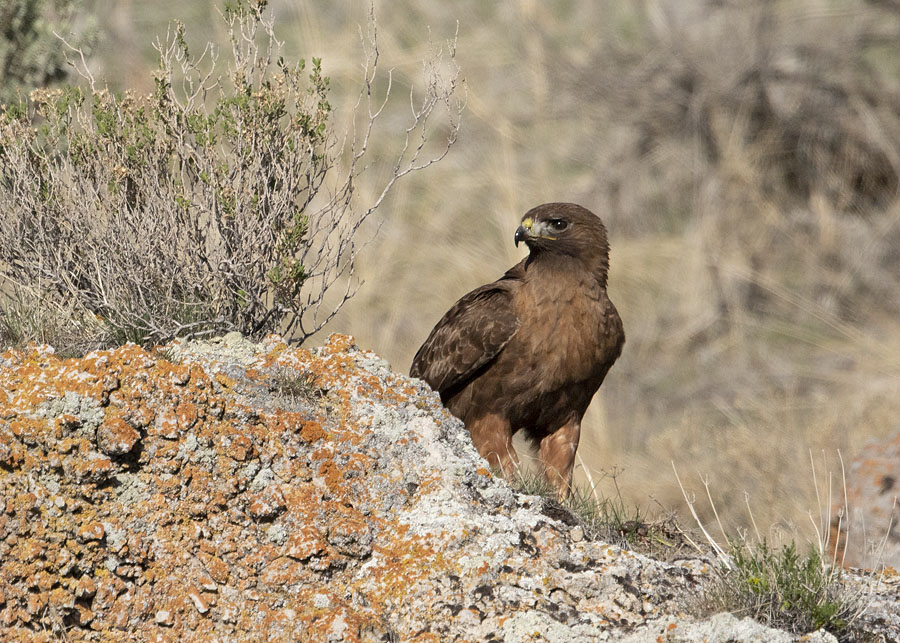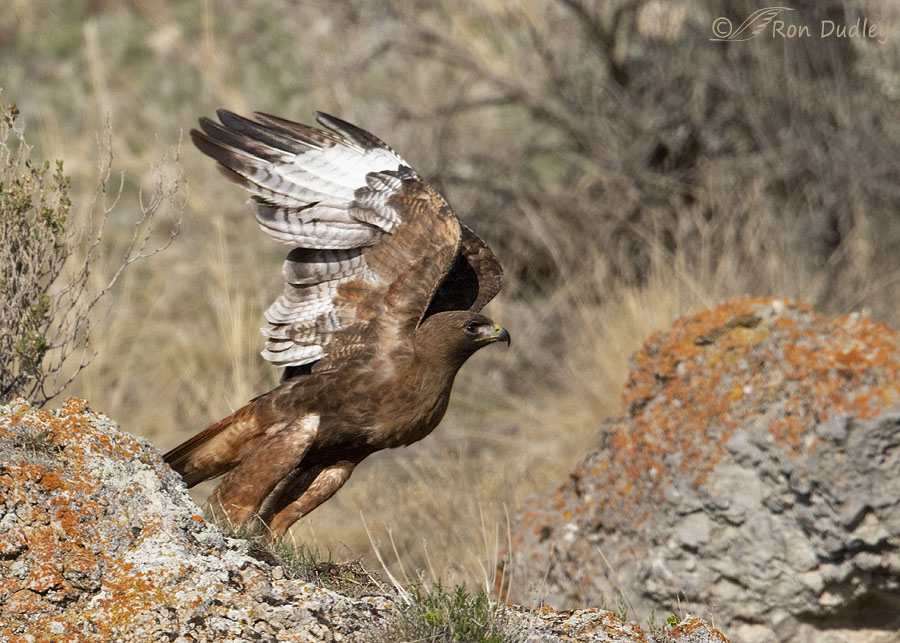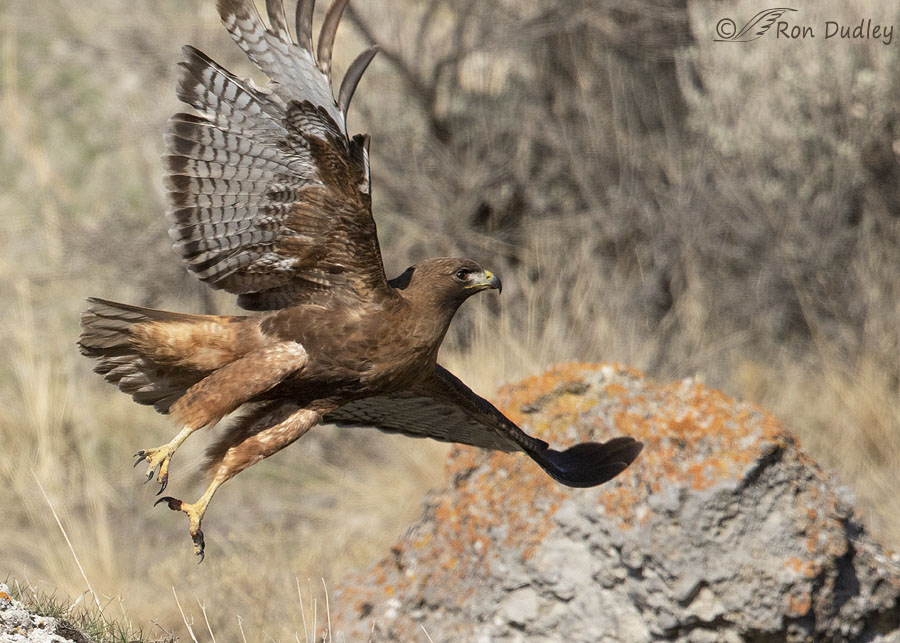Plus a word to the wise if you ever have to send your camera in for repair.

1/4000, f/8, ISO 800, Canon 7D Mark II, Canon EF 500mm f/4L IS II USM + EF 1.4 III Extender, not baited, set up or called in
Two days ago I encountered this stunning adult dark morph Red-tailed Hawk in a fairly remote area of northern Utah. When I first pulled up on her she was finishing the last few bites of her vole breakfast. While she was on the ground she stayed partly hidden behind the lichen-covered rock but for me seeing part of such a gorgeous red-tail is at least as rewarding as seeing all of a more typical one.

1/4000, f/8, ISO 800, Canon 7D Mark II, Canon EF 500mm f/4L IS II USM + EF 1.4 III Extender, not baited, set up or called in
Sadly I clipped at least one wing in several of her flight shots but at least I was able to keep all of her in frame as she lifted off.

1/4000, f/8, ISO 800, Canon 7D Mark II, Canon EF 500mm f/4L IS II USM + EF 1.4 III Extender, not baited, set up or called in
When her left wing became fully extended it became evident that she’d lost some flight feathers, probably due to molt.
I’m including this photo despite the clipped wing for two reasons – I like her flight posture and the photo allows us to see the reasons I’m referring to her as a female. Both her body size and the diameter of her tarsi indicate female to me but that’s a judgment call so I can’t be sure.
Before I processed these photos the last two weren’t quite as sharp as the first one so during processing I applied 50% more sharpening to them than I did to photo #1. There’s a reason for that, which I’ll explain in the note below.
Not all readers are interested in that much photo-geek.
Ron
Note to photographers:
Readers know that I recently sent both my primary birding lens and my primary birding camera to Canon for repair. The morning I took these photos was the first time I’d used both of them in the field since I got them back.
I know from experience that Canon camera technicians usually change at least some camera settings while they’re working on them and they never set them back before returning the camera to its owner. Before leaving on this trip I double-checked my settings and noticed that several of them had been changed so I set them back to my preferences for photographing birds.
But I missed one. They had changed my preferred back-button focus to the more traditional shutter button focus and that messed me up all morning. It meant that when I fired a burst as I followed a bird in flight my active focus point wasn’t refocusing on the bird as it moved into different planes relative to me. The result – sharp shots while the bird was perched but increasingly softer shots as the bird moved into different planes during takeoff.
I noticed it about half-way through the morning but it’s a fairly complicated process to change that particular setting back to my preferred one and I couldn’t remember how to do it so I tried to adapt my shooting style to compensate for it with little success. And that’s why the second two shots in this series originally weren’t quite as sharp as the first one. Some of the later ones in the series were even softer.
So, a word to the wise. If you ever have to send your camera in for repair be absolutely sure you check your preferred settings, all of them, after you get it back.
If you don’t you’ll be sorry. I didn’t and I am.


I really love these shots of a Red-tail I will hardly ever see!
Many thanks!
Yep, I agree. That’s a girl! And what a BEAUTY!! Sorry I’m way late.
Thanks for the confirmation, Laura. I was hoping you’d either confirm or correct me.
spectacular series Ron! Thanks for sharing!
Charlotte Norton
Thank you, Charlotte.
Stunning hawk.
Thanks, Arwen.
Stunning, great shot.
Thanks, Janice.
She is truly beautiful. Truly, rooly beautiful. Which you know.
Sigh at the technicians. Someone criticised it as sloppy, but I think it is arrogance. ‘I know more about what settings you need to use than you do’.
Thanks, EC.
Sloppy, arrogance or laziness – whatever the reason I think it’s pretty piss-poor of them not to do it. They could do it very easily and quickly but for many of their customers it’s a HUGE headache.
She IS a stunner! And a healthy-looking one at that, minus a few flight feathers, but what’s a girl to do, ‘tis the season, apparently. Lucky you to be in the right place at the right time to catch her — but too bad those Canon techs couldn’t have truly finished the job by putting the settings back to their customer’s originals. Seems rude (and sloppy) to me … but possibly I expect too much.
“Seems rude (and sloppy) to me”
I wholeheartedly agree, Chris. I’m surprised they don’t reset settings. Canon seems to be very sensitive to pleasing the repair customer, especially for Canon Professional Services members, so it seems like a no-brainer that they would do it. But they never do.
Yes, I think it is ‘the season’. Quite a few hawks I’ve photographed in the last few days have been showing significant signs of molt, including another one this morning.
Spectacular!
Thanks, Pat.
Beautiful photos and bird! She has such a rich chocolate color. She does have a slight bulge in her crop. I hope she stays in the area.
Yes, you can always add all the “photo-geek”. I have my back button set up the same. When ever my son, Eric uses my camera he takes back button off and changes other setting I like too. Usually I don’t know he has used my camera and changed things, until I go to use the camera. He even changes setting on my lens that I seldom double check. I like you don’t remember how to reset some of the settings since I don’t do it often and it is complicated where to find the setting in all the menu choices. He has heard my lecture of returning all the settings as he found them so often you think he would do it. He usually returns my lecture with his standard lecture of why am I using some of the camera settings he feels are so wrong. He so easily navigates the intricacies of the camera it amazes me!
April, what Eric does with your camera would drive me bonkers. Apparently you’re better natured about it than I would be…
What a great find and photos. Ironically, her tail appears to not be very red.
I’m no help on the camera settings. I still can’t figure out how to get my stupid cell phone to focus.
Lyle, typically their tails aren’t very red on the underside, even in adults.
I’m a cell phone dummy when it comes to photos but thankfully my phone usually recognizes me as challenged in that regard and takes up most of the slack.
The first shot is SO charming! Absolutely love it.
Thank you, Kathleen. That photo is growing on me too.
Ron, I am with you on the settings. Most of the internal setting we generally set once and go on our way. The BBF is on of them. YouTube is my friend to get these settings reset. I have a file with the links.
jake
Jake, yesterday I also used YouTube as a reminder of how to reset BBA. Very helpful if you find the right one. I thought the one by Ray Lotier was concise, well done and very helpful.
So stunning ! Especially in contrast to the lighter surroundings……I like the
“peek around the rock” pose– sort of like a fan dancer with a curtain…..
I agree, Kris. The more I look at that first photo the more I like it, which slightly surprises me.
LUV the dark morphs! Part of her hidden or not it’s a beautiful photo. Clipped wings never cease to be an issue it seems…..
Part of her hidden or not it’s a beautiful photo. Clipped wings never cease to be an issue it seems…..  Guessing the repair folks have a set routine they go through and……… When you’re on auto pilot as you need to be………..
Guessing the repair folks have a set routine they go through and……… When you’re on auto pilot as you need to be………..  Most of my cameras have been “hand me downs” so sorting all that out can take a bit of time – remembering “where” the various settings are in the menu IS a challenge… You’ve had a couple of days of it with camera related issues……
Most of my cameras have been “hand me downs” so sorting all that out can take a bit of time – remembering “where” the various settings are in the menu IS a challenge… You’ve had a couple of days of it with camera related issues…… 
“Clipped wings never cease to be an issue it seems”
That’s for damn sure, at least with me. Did it again this morning but thankfully I got some that weren’t clipped.
And yes, I’ve had more than my share of gear “issues” lately. Hopefully they’re mostly behind me now.
Excellent photos Ron – back button or not. Interested, but not very knowledgeable regarding photo geek. Will be interested to see your answer to Rick regarding his question about dark morph genetics. I have never seen a dark morph here, but would love to.
Everett, this morning I looked for this dark morph in the same area but never found her. Apparently she was alone (mateless) on the day I photographed her so maybe she was just passing through.
Don’t you have the option to save your settings to the memory card and restore later? Once you try BBF method, you can no longer go back. Thanks for the share, always learning something about birds & nature from your blog.
Elmer, yes I believe I do have that option but I’ve never done it. Hopefully I now will.
Hi Ron.
Beautiful dark morph red tailed hawk! For the first time ever, we had one visit us a few times last month. The coloring of the hawk threw me for a loop, as I wanted to ID it as a red tailed hawk, but the colors just didn’t match up…except for the tail.
I searched high and low on the internet and finally came to the conclusion that our bird was indeed a dark morph red tailed hawk, but your photos this morning are a welcome addition to the evidence that we had correctly identified our local bird.
Do you happen to know what play on genetics causes a dark morph to occur?
Thanks for your continued wonderful pictures and associated stories. I enjoy your posts very much!
Also, I got a chuckle out of your back-button issue, as I remember just how convoluted it was to initially set my Canon 7DmkII to back-button focus mode…and I know that I’d have to look it up if I had to do reset it again…not something I could possibly remember in the field.
Rick, I was looking for questions about color variations in hawks some years ago and ran into this paper online. I am glad it was still available. It is technical but I think most can follow it.
https://www.ncbi.nlm.nih.gov/pmc/articles/PMC2927923/
Thanks for the link, April. I’ll check it out later today.
Rick,
I’ll be reading April’s link (below) this afternoon to see if it throws light on your plumage question.
Now, after some research and then doing it again, I remember how to reset back button focus. But as sure as I clip wings during takeoffs I’ll forget by the time I have to do it again.
Ron, if the article is all too much with what standards of test they used you can skip down the conclusion which basically they are still studying it.
These genetic data indicate low levels of differentiation among three recognized subspecies of B. jamaicensis examined, particularly between B. j. borealis and B. j. harlani. In light of previous population genetic structure investigations of species within the genus Buteo, our findings are inconsistent with the historical designation of B. j. harlani as a separate species. Rather, the mtDNA data are consistent with contemporary subspecies nomenclature and data from both marker classes suggest that gene flow is occurring at a relatively high level among these subspecies. Additional research is necessary to fully describe the geographical variation in plumage observed in B. jamaicensis and to determine the underlying mechanisms responsible for the variation seen in B. j. harlani.
Thanks, April. The conclusion is very helpful.